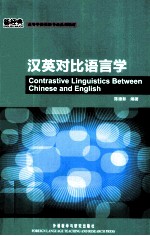
- 作 者:陈德彰著
- 出 版 社:北京:外语教学与研究出版社
- 出版年份:2011
- ISBN:9787513512916
- 标注页数:354 页
- PDF页数:369 页
请阅读订购服务说明与试读!
订购服务说明
1、本站所有的书默认都是PDF格式,该格式图书只能阅读和打印,不能再次编辑。
2、除分上下册或者多册的情况下,一般PDF页数一定要大于标注页数才建议下单购买。【本资源369 ≥354页】
图书下载及付费说明
1、所有的电子图书为PDF格式,支持电脑、手机、平板等各类电子设备阅读;可以任意拷贝文件到不同的阅读设备里进行阅读。
2、电子图书在提交订单后一般半小时内处理完成,最晚48小时内处理完成。(非工作日购买会延迟)
3、所有的电子图书都是原书直接扫描方式制作而成。
Chapter 1 Language and Thinking 1
1.1 Introduction 1
1.1.1 Definition of language 1
1.1.2 Characteristics of language 3
1.2 Comparison of English and Chinese 3
1.2.1 Reason for contrastive studies between English and Chinese 3
1.2.2 A preliminary comparison 4
Chapter 2 Words and Characters 20
2.1 English letters and Chinese characters 20
2.2 Development of Chinese characters 26
2.3 The relation between Chinese characters and words 31
2.4 Motivation of words 41
2.5 Meaning of words 45
2.6 Word as a unit 56
Chapter 3 Primal Words and Secondary Words 59
3.1 Introduction 59
3.2 Formation of secondary words 60
3.2.1 Combining 61
3.2.2 Examples of a special type of derivation 61
3.2.3 Compounding 74
3.3 Shortening 76
3.3.1 Acronym 76
3.3.2 Blending 78
3.3.3 Clipping 81
3.3.4 Shortening of Chinese words 82
3.4 Other means of new word formation 87
3.4.1 Conversion 87
3.4.2 Borrowing 88
3.5 Analogy 97
Chapter 4 Intonation and Tone 101
4.1 Intonation 101
4.2 Syllable 103
4.3 Sound effect of poems 109
Chapter 5 Conception and Nomenclature 114
5.1 Lexical disparity 114
5.2 Lexeme gap 115
5.2.1 Different motivations behind nomenclature 115
5.2.2 Different ways of grouping things 120
5.2.3 Differences among synonyms 124
5.2.4 Things unique to a culture 126
5.3 Semantic gap 128
5.3.1 Different reference meanings 128
5.3.2 Different extended meanings 134
5.3.3 Different directions of meanings 135
5.4 Usage Gaps 137
5.4.1 Transitivity 137
5.4.2 Differences caused by word formation 139
5.4.3 Differences caused by flexible usage—conversion 140
5.4.4 Differences caused by different grammatical meanings between corresponding words 141
Chapter 6 Abstraction and Concretion 147
6.1 Abstraction and abstract meaning 147
6.2 杯as an example 150
6.3 Further abstraction 159
6.4 Abstraction and sentence structure 165
6.5 Concretization of abstract nouns 168
Chapter 7 Stativeness and Dynamicity 174
7.1 Introduction 174
7.2 The verb 175
7.2.1 Functions of verbs 176
7.2.2 Classification of verbs 177
7.2.3 Morphological changes of English verbs 181
7.2.4 The use of verbs in the sentences 182
7.3 Verbalization of nouns 185
7.4 Action or motion implied in other parts of speech 192
7.4.1 The noun 192
7.4.2 Other parts of speech 201
7.5 At the syntactic level 204
Chapter 8 Overtness and Covertness 212
8.1 Markers 212
8.2 Parts of speech and their function in the sentence 214
8.3 The article 222
8.4 Marker of the plural 231
8.5 Chinese auxiliaries的,地,and得 238
8.5.1 的 238
8.5.2 地 241
8.5.3 得 242
8.6 The passive 246
8.7 Punctuation marks 248
Chapter 9 Rigidity and Flexibility 251
9.1 General difference between Chinese and English grammar 251
9.2 Definition of the sentence 252
9.3 Classification of sentences 256
9.3.1 Some special Chinese sentence patterns 267
9.4 Elements of the sentence 273
9.4.1 The subject 273
9.4.2 Relation between the verb and its object 285
9.5 Word order 292
9.5.1 Adverbials 296
9.5.2 Relative clauses 302
9.5.3 Inversion 304
9.6 Parataxis and hypotaxis 309
9.6.1 Connectives 310
Chapter 10 Objectivity and Subjectivity 330
10.1 Language and subject 330
10.2 Daily usage of the language 333
10.3 Subjective and objective standards 335
10.4 Depiction of mental activities in English 338
10.5 The passive voice 341
10.6 Animated and inanimate subjects 343
10.7 Different levels of objectivity 345
Bibliography 349
Recommended Readings 351
